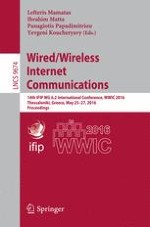2016 | Buch
Wired/Wireless Internet Communications
14th IFIP WG 6.2 International Conference, WWIC 2016, Thessaloniki, Greece, May 25-27, 2016, Proceedings
herausgegeben von: Lefteris Mamatas, Ibrahim Matta, Panagiotis Papadimitriou, Yevgeni Koucheryavy
Verlag: Springer International Publishing
Buchreihe : Lecture Notes in Computer Science
